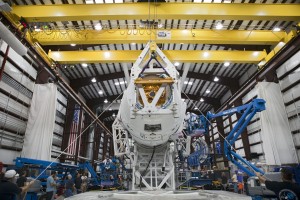
On Sunday night, SpaceX launched its Dragon spacecraft, destined for the International Space Station (ISS), to dramatic effect. The spacecraft was launched using the company’s Falcon 9 rocket powered launch system, whose first successful launch took place in June of 2010.
After what looked like a nominal take-off, the in-flight computer noticed complications with one of the nine rockets, which had lost pressure and shut down completely. Luckily, Falcon 9 responded as planned, burning the remaining engines longer than planned to make up for the lost engine. SpaceX reports that the launch system, in fact, only needs seven of the nine rockets for a successful launch, so even a second loss should not have ruined the flight.
Despite the engine failure, the Dragon spacecraft was successfully launched towards the ISS. This resupply mission, SpaceX CRS-1, marks the first flight under SpaceX’s $1.6 billion contract with NASA to deliver cargo to and from the ISS. Dragon is carrying refueling and resupply cargo to the six-member crew currently at the station.
NASA, since facing increasingly severe budget cuts, had lost its ability to supply the station with U.S. spacecraft. Thanks to its partnership with the private company, however, the U.S. may have a recurring presence at the ISS once again.

In December of 2010, SpaceX became the first private company to successfully launch and return a spacecraft from orbit. The benefit of this was immense. NASA is tied down in bureaucracy which often causes unnecessary spending and time delays; a private company like SpaceX, however, funded by private equity and a variety of investors, has much more freedom to develop and deploy new aircraft.
NASA has also partnered with SpaceX to design new human spaceflight craft that it hopes will eventually be used for both scientific and commercial purposes. With SpaceX and several other private companies working together with NASA to develop new technologies, the possibility of the United States resuming its manned spaceflight program arises for the potentially very near future.
Amidst any worries that a private, less regulated organization could successfully launch aircraft into orbit, SpaceX has continued to impress again and again. Since its first successful launch, it has continued to complete missions at a much faster rate and lower price than NASA could do alone. Engine failure included, Dragon’s launch looks to be a major accomplishment for the agreement between SpaceX and NASA. The feat shows that private companies and the government can, in fact, work together. Even with NASA struggling to stay afloat, don’t count the United States out of the battle for space supremacy, at least not if SpaceX has anything to say about it.
Dragon is expected to reach the International Space Station on October 10, when its cargo will be unloaded. Dragon will be refilled with cargo to be sent back to Earth. For updates on the status of the mission, check the SpaceX updates page.

